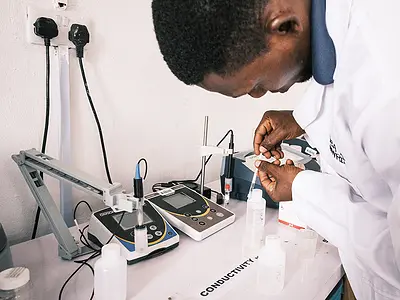
It’s official! The United States Environmental Protection Agency (EPA) has finalized its first ever regulation for six PFAS compounds—also known as per- and polyfluoroalkyl substances—in drinking water.
What’s new about this regulation? Haven’t we had water regulations for a long time?
While the Safe Drinking Water Act was passed in 1974, the U.S. only regulates around 90 contaminants under ‘primary drinking water standards,’ which are predominantly health-based standards also known as a maximum contaminant level, or MCL. While select PFAS compounds have been tested by water utilities per EPA request under the Unregulated Contaminant Monitoring Rule in the last decade, this is the first ever enforceable health-based standard set for any PFAS compounds in drinking water. With this new regulation, water utilities across the U.S. now have additional contaminants they are required to monitor and treat as needed to meet water standards.
How does this affect what’s flowing at your tap?
- The saying ‘water is life’ really comes alive when we think about potential exposure from contaminants in drinking water. The MCLs for the six PFAS compounds that are included are set to very low “part per trillion” levels. Not only will the new regulation address these PFAS in the water itself, it also affects water used for food preparation, irrigation and gardening, bathing, and more.
- Because many water systems contain PFAS in their source water from industrial manufacturing, agricultural use of PFAS-containing products or biosolids, and residential use, many utilities will require additional water treatment to meet the new standards. Some have already started employing “tertiary” treatment methods like activated carbon to reduce levels before water is distributed to customers. This translates to less PFAS at the tap for households and communities across the U.S. served by municipal water utilities.
What else can be done to reduce PFAS exposure?
This regulation is the culmination of significant research by academic researchers and organizations, activism by community groups, and research-informed policies by federal agencies. Additional efforts to tackle PFAS concerns include:
- Addressing the source – Water monitoring and treatment would not be necessary if PFAS were not manufactured, used, and disposed of at such high volumes. To do this will require new, safer benign chemistries be developed and thoroughly vetted for unintended consequences. It may also require consumers to accept a lower performance in products they love and use every day, but this is a small price to pay to protect the water we drink.
Regulating PFAS as a class, rather than individual compounds – There are approximately 15,000 PFAS compounds and this regulation addresses six. While the various compounds can behave differently, research shows that all PFAS have similar characteristics. There are also laboratory tests to identify the universe of potential PFAS rather than only targeted compounds. If we can regulate PFAS as an entire class, like was done with “dioxin-like compounds,” we could better protect public health more expediently.
- Finding the funds – The Bipartisan Infrastructure Law has funding available to support PFAS efforts. This country-wide issue will require ongoing treatment to meet standards in certain areas.
- Developing equitable solutions – This regulation only affects those served by public water supplies. Households served with a private well still do not have support for testing their water or treating it, despite being at a higher risk of water quality concerns compared to the average household on municipal water.
- Making more informed purchase decisions – If you actively choose PFAS-free products, not only will you help reduce demand for PFAS, but you also reduce your potential exposure to PFAS from direct use in consumer products. For example, wearing water repellent clothing or cooking with some non-stick cookware can increase your risk of exposure.
- Incentivizing alternatives – In addition to changing consumer preferences, we should work across sectors to identify the reason PFAS is useful in individual products and find appropriate alternatives that are shown to be less toxic. This would set companies up to move toward a PFAS-free future.
Where can you go to learn more about PFAS in manufacturing and consumer products?
- Our team at RTI developed a PFAS white paper in partnership with the Consumer Product Safety Commission on PFAS sources, market trends, and potential exposures in consumer products. Check out the whitepaper.
- We also developed the PFAS Commodity Market Trends mapper, which can be used to explore information on PFAS-producing Facilities, PFAS-releasing Facilities, Domestic PFAS Trade Volumes, and International PFAS Trade Volumes.
- Learn more about the new EPA regulation.


